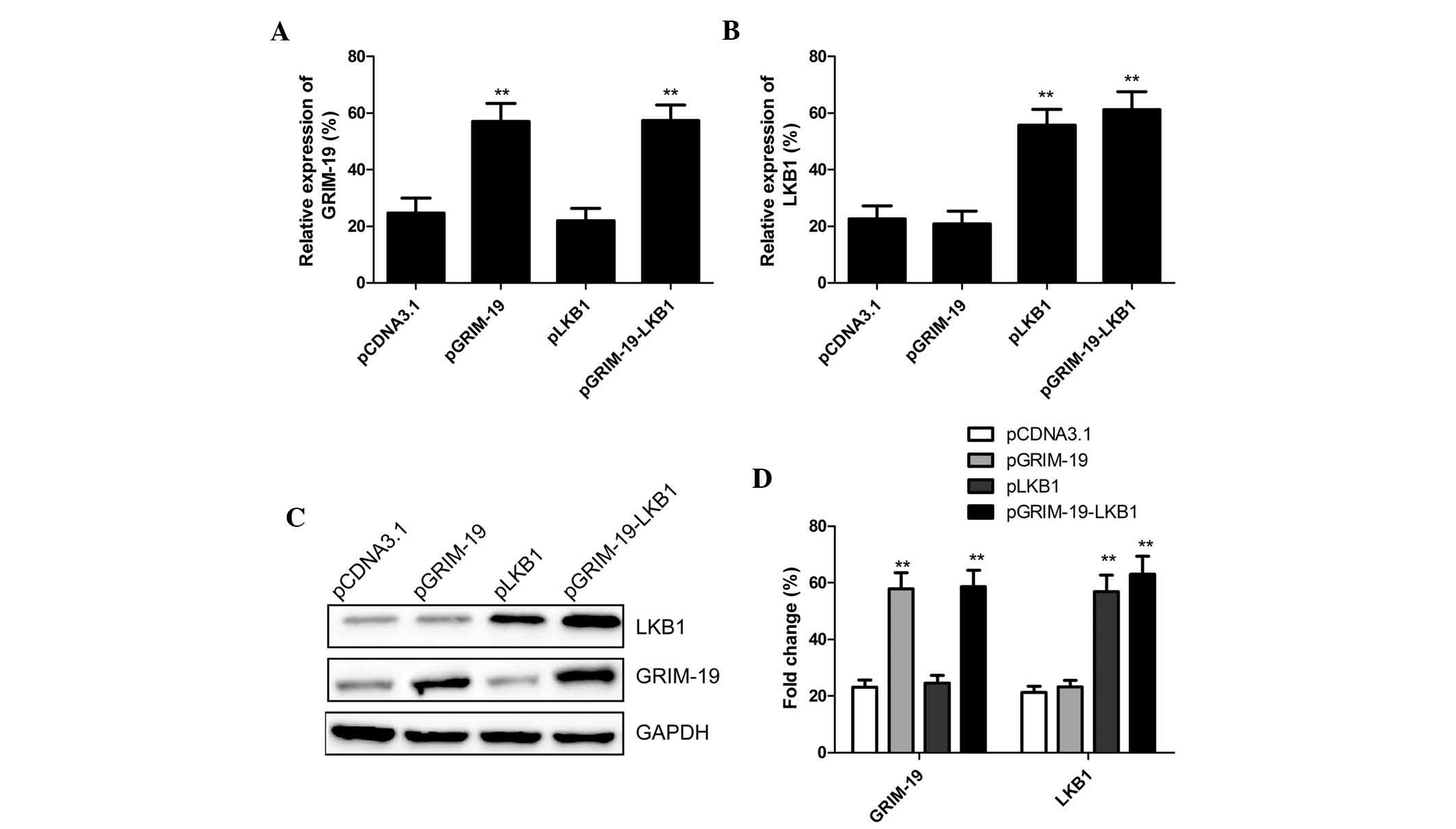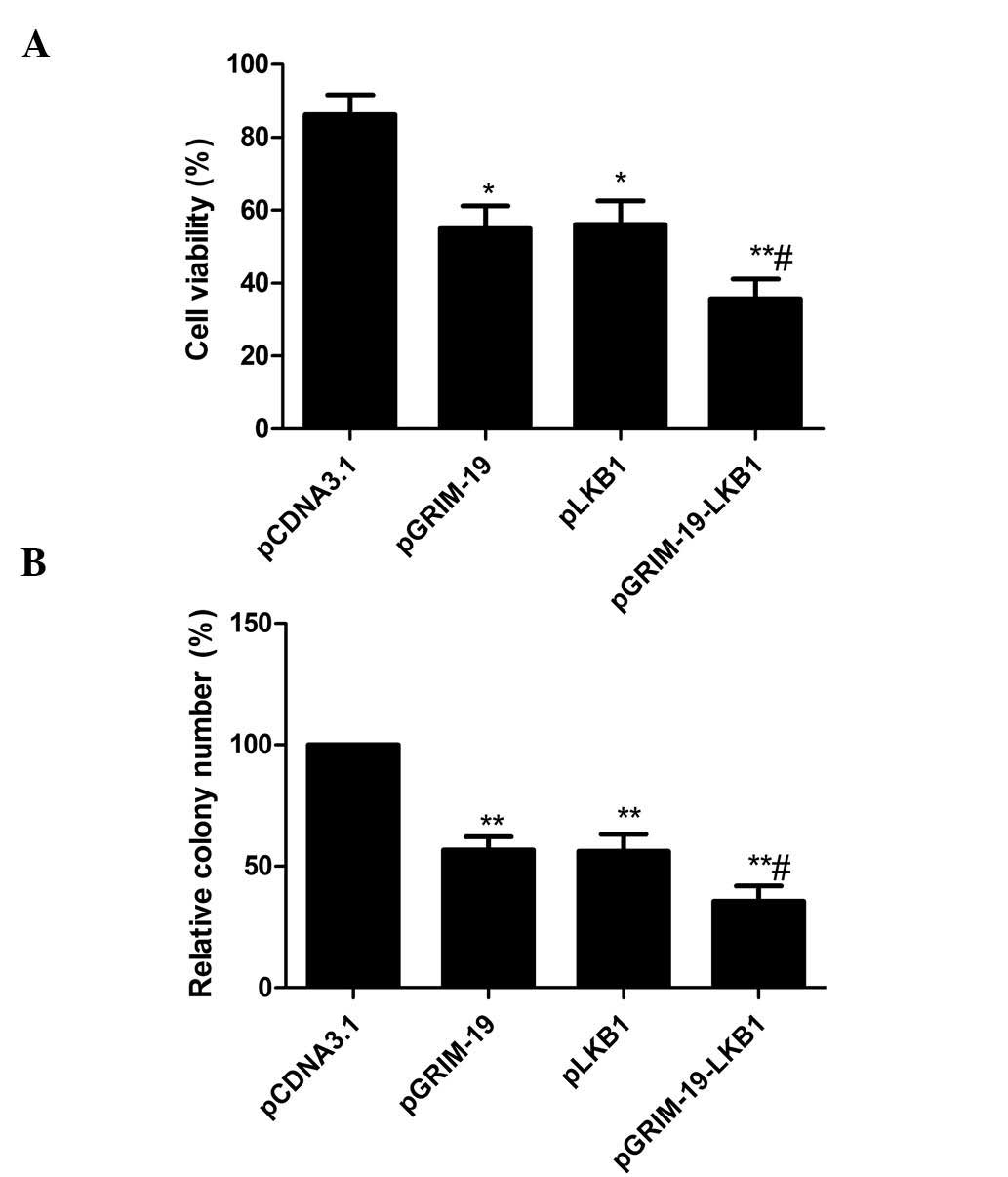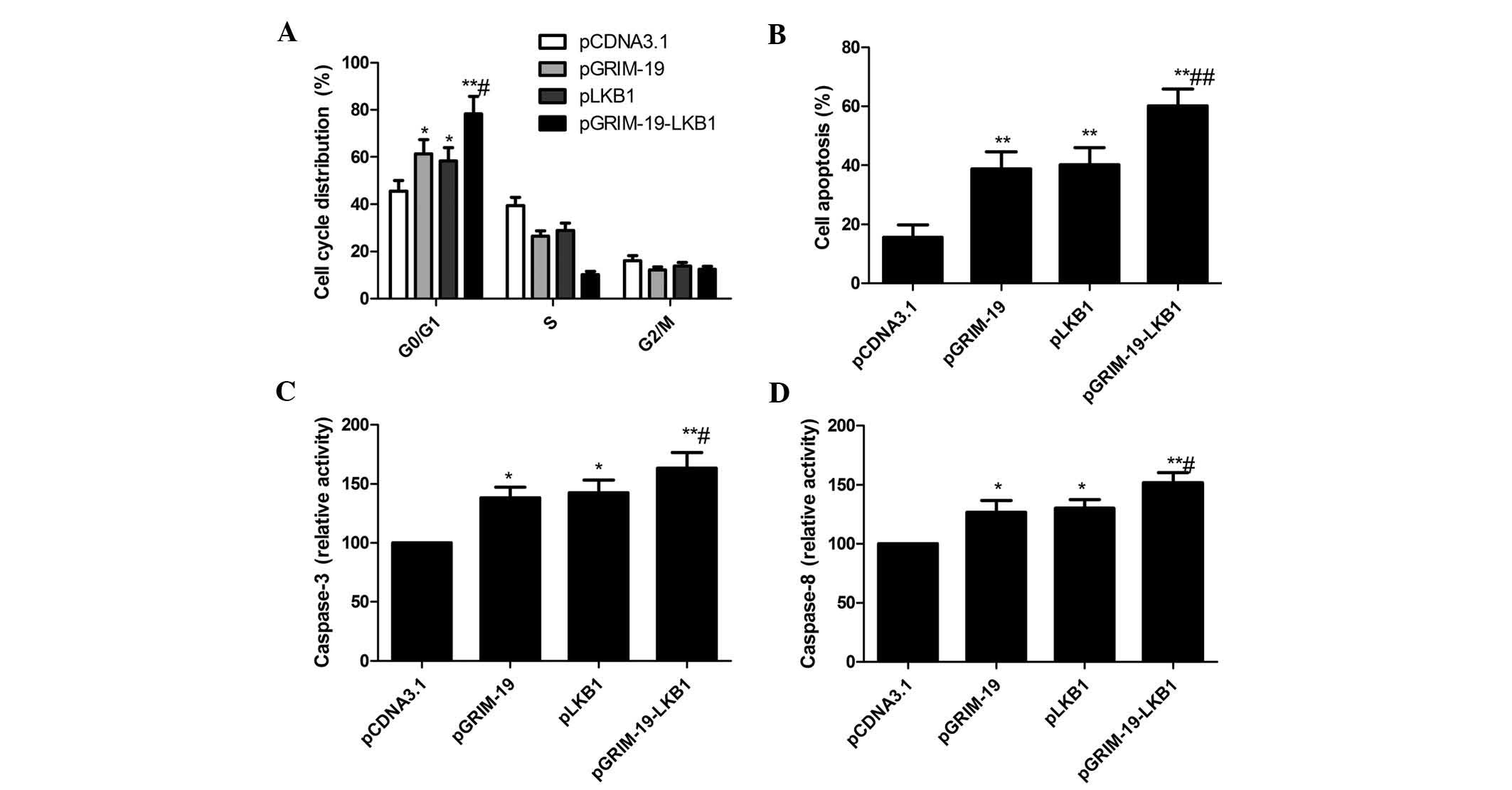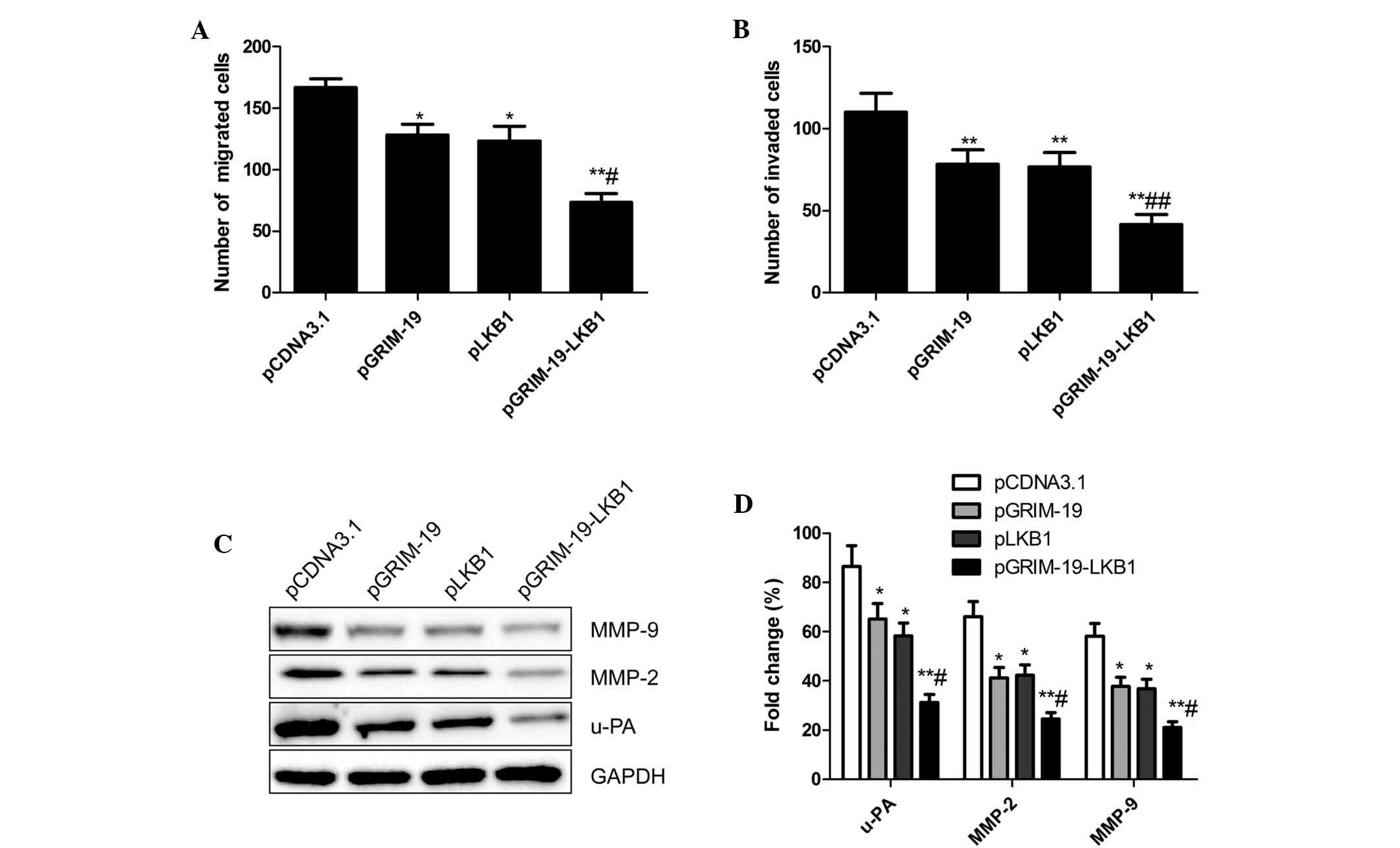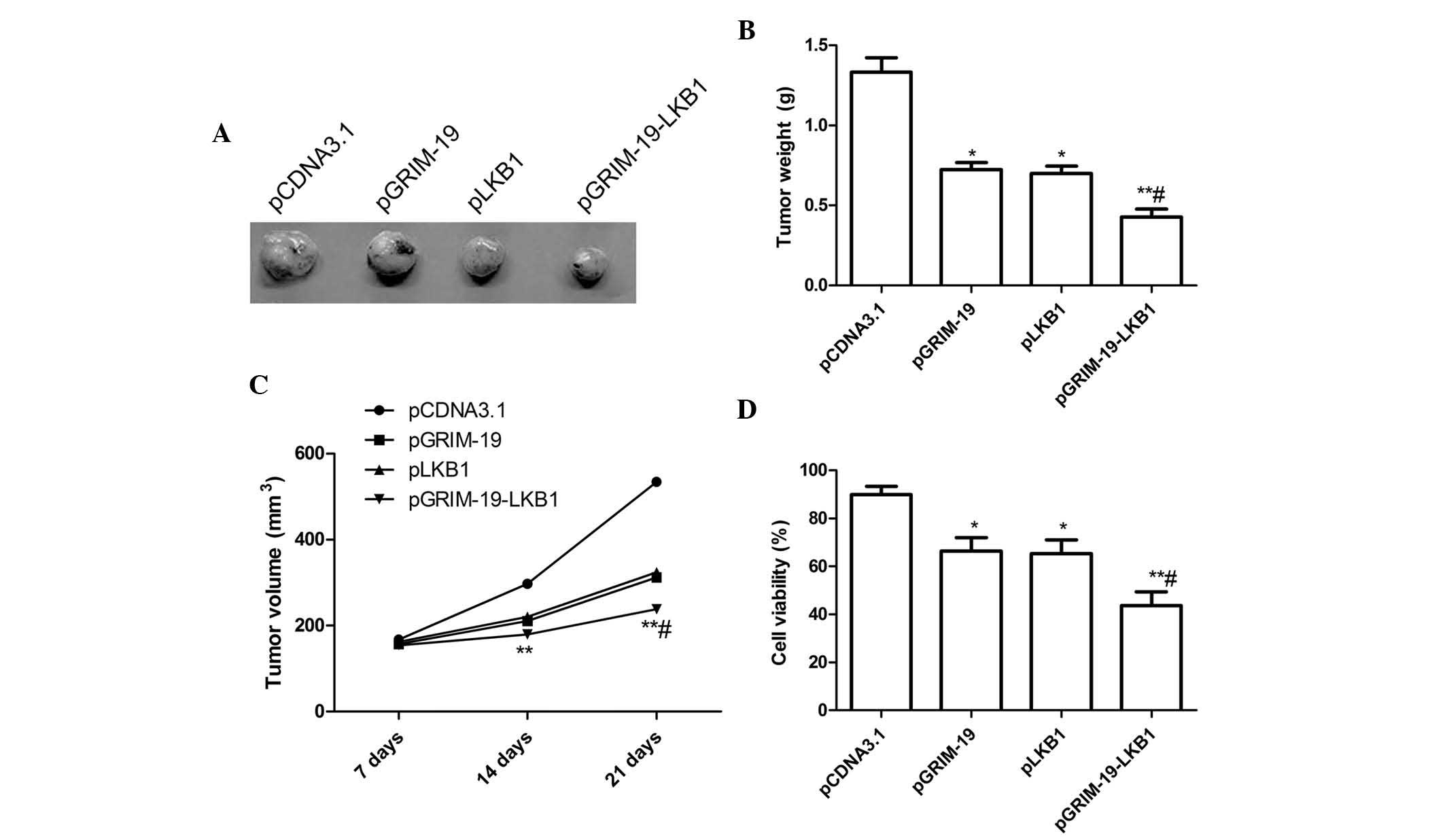Additive effects of eukaryotic co‑expression plasmid carrying GRIM‑19 and LKB1 genes on breast cancer in vitro and in vivo
Retraction in: /10.3892/mmr.2021.12226
- Authors:
- Published online on: September 30, 2015 https://doi.org/10.3892/mmr.2015.4393
- Pages: 7665-7672
Abstract
Introduction
Breast cancer (BC) is the most common malignancy in women and is a leading cause of cancer-associated mortality of women worldwide (1). An estimated 1,300,000 of women will be diagnosed with BC and >450,000 will succumb to the disease each year worldwide (2). Although several types of therapies, including surgery, radiotherapy, chemotherapy and hormone therapy, have been designed to treat BC (3), the outcome remains poor due to high recurrence rates after tumor resection and chemotherapy and with radiotherapy offering unsatisfactory response rates (4). Therefore, novel treatment strategies for breast cancer are urgently required. Gene therapy represents a promising alternative to conventional therapies.
Gene associated with retinoid-interferon (IFN)-induced mortality 19 (GRIM-19), a member of the GRIM family located on human chromosome 19p13.1, codes for a 16-kDa protein in the cytoplasm and nucleus of the cells and also in the mitochondria (5,6), and has been identified as a growth-suppressive gene involved in the IFN-β- and retinoic acid-induced death of mammary carcinoma cells (7). Growing evidence showed that overexpression of GRIM-19 inhibited cell proliferation, migration and invasion, as well as induced apoptosis in several types of cancer cell (8–12). Zhou et al (13) demonstrated that GRIM-19 expression was decreased in breast cancer tissues, and down-regulation of GRIM-19 was shown to correlated with aggressive clinicopathological features of breast cancer, including lymph node metastases and thus an advanced tumor-nodes-metastasis stage. In addition, a recent study by our group showed that upregulation of GRIM-19 suppressed cell proliferation, colony formation, migration and invasion, as well as induced cell apoptosis in human breast cancer cells, which suggested that GRIM-19 may act as a novel potential target for the treatment of breast cancer (14).
Liver kinase B1 (LKB1), located on chromosome 19p13.3, encodes the ~48-kDa multi-tasking kinase protein-LKB1 and is a candidate tumor suppressor gene (15). Altered LKB1 expression has been associated with the development and growth of various types of cancer (16). Growing evidence demonstrated that overexpression of LKB1 inhibited cell proliferation and migration, and induced apoptosis in several types of cancer cell, including breast cancer (17–20). In addition, gene therapy by introduction of the human LKB1 gene into tumors has shown a significant tumor-suppressive efficacy in animal models as well as in human clinical trials (21–23). These studies implied that gene therapy by introduction of LKB1 was also a good strategy to treat breast cancer.
The onset and progression of tumors is a highly complex process; therefore, it is challenging to cure cancer using a single therapeutic gene. GRIM-19 and LKB1 act as tumor suppressor genes and are suitable for cancer gene therapy. To the best of our knowledge, no studies have previously pursued a therapeutic strategy using these two genes simultaneously to treat breast cancer. Therefore, the aim of the present study was to evaluate the therapeutic potential of co-expression of GRIM-19 and LKB1 in breast cancer in vitro and in vivo.
Materials and methods
Cell lines and cell culture
The MCF-7 human breast cancer cell line was obtained from the Cell Bank of Type Culture Collection of Chinese Academy of Sciences, Shanghai Institute of Cell Biology (Shanghai, China) and cultured in Dulbecco's modified Eagle's medium (DMEM; Gibco-BRL, Invitrogen Life Technologies, Carlsbad, CA, USA) supplemented with 10% fetal bovine serum (FBS; Gibco-BRL), 100 U/ml penicillin and 0.1 mg/ml of streptomycin (Gibco-BRL) and 37°C in a humidified atmosphere containing 5% CO2.
Plasmid construction and transfection
A series of eukaryotic expression plasmids was constructed using pcDNA3.1 vector (Invitrogen Life Technologies) on request as follows: pcDNA3.1-GRIM-19 (named as pGRIM-19) encoding the GRIM-19 gene; pcDNA3.1-LBK1 (named as pLKB1) containing the LKB1 coding region; and the co-expression plasmid pcDNA3.1-GRIM-19-LKB1 (named as pGRIM-19-LKB1) expressing GRIM-19 as well as LKB1.
MCF-7 cells were seeded at a density of 3×105 cells per well onto six-well plates and allowed to attach overnight. The cells were transfected with different plasmids (pCDNA3.1, pGRIM-19, pLKB1 and pGRIM-19-LKB1) using Lipofectamine 2000 (Invitrogen Life Technologies) according to the manufacturer's instructions for an additional 72 h prior to analysis of mRNA and protein levels.
Reverse-transcription quantitative polymerase chain reaction (RT-qPCR)
The mRNA expression levels of GRIM-19 and LKB1 were examined using RT-qPCR. In brief, MCF-7 cells were collected 72 h following transfection with various plasmids. Total RNA was extracted using the TRIzol reagent (Invitrogen Life Technologies). RNA was then reverse-transcribed into cDNA using a Primescript™ RT reagent kit (Takara Bio Inc., Dalian, China) according to the manufacturer's instructions. According to the cDNA sequences of GRIM-19 and LKB1 in the GenBank (http://www.ncbi.nlm.nih.gov/genbank/) database, corresponding primers were designed and synthesized by Genomics company (Guangzhou, China). The primers were as follows: GRIM-19 forward, 5′-ATGGCGGCGTCAAAGG-3′ and reverse, 5′-CAGGGCCTACGTGTACCACAT-3′; LKB1 forward, 5′-TGCTGAAAGGGATGCTTGAGTA-3′ and reverse, 5′-GGATGGGCACTGGTGCTT-3′; GAPDH forward, 5′-CCACTCCTCCACCTTTGAC-3′ and reverse, 5′-ACCCTGTTGCTGTAGCCA-3′. All PCR products were detected by Premix Taq Version 2.0, Loading dye mix (cat no. D334A, Takara Bio Inc.) using an ABI 7900 Fast system (Applied Biosystems, Thermo Fisher Scientific, Waltham, MA, USA). GAPDH was used as an internal control. Amplification of GRIM-19, LKB1 and GADPH was performed using one cycle at 95°C for 5 min, 30 cycles of 95°C for 20 sec, 60°C for 40 sec, 72°C for 30 sec, and a final 72°C for 5 min. The PCR products were subjected to 1% agarose gel (Sigma-Aldrich) electrophoresis. GAPDH served as an internal reference to normalize the expression levels of the target gene. Gel images were analyzed using a UVI band map program (UVItec Ltd., Cambridge, UK). The experiments were repeated three times.
Western blot analysis
For western blot analyses, after 72 h of transfection, cells were harvested and lysed by incubation on ice for 30 min in lysis buffer (Sigma-Aldrich, St. Louis, MO, USA) containing complete protease inhibitor cocktail (Roche Diagnostics, Basel, Switzerland). Protein from cell supernatants as well as lysates was quantified using the bicinchoninic acid protein assay kit (Pierce Biotechnology, Inc., Rockford, IL, USA). Equal amounts of protein (30 µg) were loaded in each lane, separated by 10–15% SDS-PAGE and then transferred onto polyvinylidene difluoride membranes. The membranes were incubated for 2 h in PBS supplemented with Tween 20 (Sigma-Aldrich) and with 5% nonfat milk to block non-specific binding. The membranes were incubated overnight at 4°C with the following antibodies: Rabbit monoclonal anti-human matrix metalloproteinase (MMP)-2 (1:1,000; cat. no. sc-13132; Cell Signaling Technology, Inc., Danvers, MA, USA), mouse monoclonal anti-human MMP-9 (1:2,000; cat. no. sc-21773; Santa Cruz Biotechnology, Inc., Dallas, TX, USA), mouse monoclonal anti-human plasminogen activator, urokinase (u-PA; 1:2,000; cat. no. sc-59727; Santa Cruz Biotechnology, Inc.), mouse monoclonal anti-human GRIM-19 (1:1,000; cat. no. sc-365045; Santa Cruz Biotechnology, Inc.) and mouse monoclonal anti-human LKB1 (1:2,000; cat. no. sc-374300; Bedford, MA, USA). Mouse monoclonal anti-human GAPDH (1:10,000; cat. no. sc-47724; Santa Cruz Biotechnology, Inc.) was used as a loading control. The membranes were incubated with goat anti-mouse horseradish peroxidase (HRP)-conjugated immunoglobulin G (1:5,000; cat. no. sc-2005; Santa Cruz Biotechnology, Inc.) and goat anti-rabbit HRP-conjugated immunoglobulin G (1:10,000; cat. no. sc-2004; Santa Cruz Biotechnology, Inc.), and protein bands were observed under X-ray film using an enhanced chemiluminescence detection kit (Beyotime Institute of Biotechnology, Haimen, China).
Cell proliferation and colony formation assays
Cell viability was determined using an MTT assay. MCF-7 cells were transfected with different plasmids and cultured for 72 h, and cell viability was detected using a microplate reader (570 nm; SpectraMax 190; Molecular Devices Corp., Sunnyvale, CA, USA) following incubation of the cells with MTT solution (Sigma-Aldrich) and dissolving of formazan crystals in DMSO (Sigma-Aldrich) as previously described (24). The mean proliferation of cells without any treatment was set as 100%. For the colony formation assay, MCF-7 cells transfected with different plasmids were plated in six-well plates at a low density (1×103 cells/well) and then cultured for 10 days. Cells were then fixed with 4% paraformaldehyde for 20 min and counted after staining with 1% crystal violet (Sigma-Aldrich). The experiments were performed in triplicate wells and at least three independent experiments were performed.
Cell cycle distribution and apoptosis assay
Flow cytometry was used to detect cell cycle distribution and apoptosis. Briefly, MCF-7 cells were collected 24 h after transfection with different plasmids. For cell cycle analysis, the cells were incubated with 2 µg/ml of RNaseA (Sigma-Aldrich, St. Louis, MO, USA) in phosphate-buffered saline (200 µl) and 0.1 µg/ml propidium iodide (Sigma-Aldrich) in 0.6% Nonidet P-40 (Sigma-Aldrich) on ice for 30 min. The DNA contents of the samples were immediately measured using a FACS-Calibur™ flow cytometer (BD Biosciences, Franklin Lakes, NJ, USA) and were assayed using CellQuest software (BD Biosciences). Apoptosis was detected using a commercial Annexin V-fluorescein isothiocyanate detection kit (Keygen, Nanjing, China) according to the manufacturer's instructions. Cells were subjected to flow cytometric analysis and the apoptotic rate was quantified using CellQuest 2.7 software (BD Biosciences). As an additional indicator of apoptosis, caspase-3 and caspase-8 activity was measured using caspase colorimetric protease assay kits (Millipore Corp., Billerica, MA, USA) according to the manufacturer's instructions.
Cell migration and invasion assays
The migration and invasion of cells were assessed using a Transwell chamber with 8-mm pore filters (Millipore Corp.). Briefly, 48 h post-transfection, the MCF-7 cells were harvested with trypsin and re-suspended in serum-free DMEM. Subsequently, 2×104 transfected cells suspended in 200 µl were placed into the upper chamber of the transwell inserts with a non-coated membrane (24-well insert; 8 mm pore size; Millipore Corp.) or coated with Matrigel (BD Biosciences) for the transwell migration or invasion assays, respectively. DMEM medium supplemented with 10% FBS was added to the lower chambers. Following culture for 24 h (migration assay) or 48 h (invasion assay), the cells that remained on the upper side of the filters were removed, and the cells that migrated to the lower side of the filters were fixed with 100% methanol (Sigma-Aldrich), stained with 0.2% crystal violet. The number of migrating and invading cells was analyzed by counting the penetrating cells in five random fields under an IX51 inverted microscope (Olympus Corporation, Tokyo, Japan) at ×200 magnification.
In addition, MMP-2, MMP-9 and u-PA protein expression was determined by western blot as an additional indicator of cell invasion and migration.
In vivo efficacy study in a xenograft tumor model
A total of 40 female BALB/c nude mice (20–25 g) at the age of 6–8 weeks were obtained from the Laboratory Animal Center of Jilin (Changchun, China), kept in filter-topped cages with standard rodent chow and water available ad libitum, and a 12 h light/dark cycle at room temperature and 50–60% humidity. The experiments were performed according to the national regulations and approved by the Animal Experiments Ethical Committee of Jilin University (Changchun, China).
Subcutaneous breast carcinoma-derived tumors were induced by inoculation of 2×106 human MCF-7 cells into the right flank. The tumor size was measured in two dimensions with a caliper-like instrument. Individual tumor volumes (V) were calculated using the following formula: V = (length × width2)/2. When the tumor volume reached 100 mm3, mice were randomly divided into groups (n=10), which were intravenously treated with 40 µg pCDNA3.1, pGRIM-19, pLKB1 or pGRIM-19-LKB1 plasmid, respectively, every three days. The tumor size was measured every five days. Mice were sacrificed by cervical dislocation on day 21 and tumors were resected and weighed. In addition, spleen tissues were collected and cultured for a splenocyte surveillance study by MTT assay as previously described (24).
Statistical analysis
Values are expressed as the mean ± standard deviation of results from at least three independent experiments. Statistical differences between groups were evaluated by analysis of variance followed by Dunnett's post-hoc test. All data were analyzed using the SPSS® statistical package, version 19.0 (International Business Machines, Armonk, NY, USA) and GraphPad Prism version 5.01 (GraphPad Software, La Jolla, CA, USA) for Windows®. P<0.05 was considered to indicate a statistically significant difference, and P<0.01 was considered to indicate a highly significant difference between values.
Results
Effect of plasmid transfection on mRNA and protein expression of GRIM-19 and LKB1
Three plasmids (pGRIM-19, pLKB1 and pGRIM-19-LKB1) were constructed that were capable of expressing the tumor suppressors GRIM-19 and/or LKB1. Following transfection of these plasmids into MCF7 cells, mRNA and protein levels of GRIM-19 and LKB1 were determined using RT-qPCR and western blot analysis, respectively. The mRNA and protein expression levels of GRIM-19 and LKB1 were similar among the cells transfected with pGRIM-19 and pLKB1 alone and those transfected with pGRIM-19-LKB1 (Fig. 1).
Additive effects of co-expressed GRIM-19 and LKB1 on proliferation and colony formation of MCF-7 cells
The effects of co-expression of GRIM-19 and LKB1 on tumor cell proliferation were determined in MCF-7 cells by analyzing the viability of cells at 72 h after transfection. As shown in Fig. 2A, inhibition of cell proliferation was observed in MCF-7 cells transfected with pGRIM-19 or pLKB1. However, transfection with pGRIM-19-LKB1 resulted in an enhanced inhibitory effect compared with that following individual transfection, indicating an additive effect of the two genes.
Next, the effects of co-expression of GRIM-19 and LKB1 on tumor cell colony formation were determined in MCF-7 cells. Following 10 days of incubation, cell colony formation in the pGRIM-19, pLKB1, and pGRIM-19-LKB1 groups was significantly diminished relative to that in the blank vector groups (P<0.05) (Fig. 2B). Compared to the single gene treatment groups, the lowest incidence of colony formation was observed in the co-expression group (P<0.05) (Fig. 2B).
Additive effects on cell cycle distribution and apoptosis of MCF-7 cells by co-expression of GRIM-19 and LKB1
The effects of co-expression of GRIM-19 and LKB1 on the cell cycle of MCF-7 cells were analyzed by flow cytometry. As shown in Fig. 3A, MCF-7 cells transfected with pGRIM-19 or pLKB1 showed arrest in G0/G1 phase, while transfection with pGRIM-19-LKB1 significantly enhanced this effect (P<0.05) (Fig. 3A).
To study the effects of co-expression of LKB1 and GRIM-19 on cell apoptosis, flow cytometric analysis was performed. As shown Fig. 3B, the apoptotic rate was increased in MCF-7 cells transfected with pGRIM-19 (38.78%) or pLKB1 (40.21%) alone, while a significant enhancement of apoptosis was observed in MCF-7 cells transfected with pGRIM-19-LKB1 (60.13%).
To determine the potential mechanism of decreases in cell viability in vitro, caspase-3 and caspase-8 activity was determined. The activity of caspase-3 and caspase-8 was significantly increased in the pGRIM-19, pLKB1 and pGRIM-19-LKB1 treatment groups compared with blank vector group (P<0.05) (Fig. 3C and D). Furthermore, co-expression group showed the highest level of caspase activation (P<0.05) (Fig. 3C and D). These results demonstrated that co-expression of GRIM-19 and LKB1 jointly induced apoptosis in breast cancer cells.
Additive effects of co-expression of GRIM-19 and LKB1 on cell cycle distribution and apoptosis of MCF-7 cells
In order to assess the inhibitory effects of co-expression of GRIM-19 and LKB1 on breast cancer cell migration and invasion in vitro, a Transwell assay was performed. As shown in Fig. 4A, migration of MCF-7 cells transfected with pGRIM-19, pLKB1 and pGRIM-19-LKB1 was significantly reduced compared to that of cells transfected with blank vector (P<0.01). In addition, cell migration in the co-expression group was lower than that in the single gene transfection group (P<0.05) (Fig. 4A). In addition, the invasive capacity of the cells was significantly decreased in the pGRIM-19, pLKB1 and pGRIM-19-LKB1 treatment groups relative to that in the blank vector group (P<0.05) (Fig. 4B). An enhanced inhibition of invasion was observed in MCF-7 cells transfected with co-expression plasmid pGRIM-19-LKB1 (Fig. 4B).
These results suggested that co-expression of GRIM-19 and LKB1 had an inhibitory effect on migration and invasion; therefore, the effects of pGRIM-19-LKB1 on the expression of u-PA, MMP-2, MMP-9 in breast cancer cells was assessed by western blot analysis. An obvious decrease in MMP-2, MMP-9 and u-PA protein levels in cells treated with pGRIM-19, pLKB1 and pGRIM-19-LKB1 compared those in the blank vector groups was observed (P<0.05) (Fig. 4C and D). The reduction in MMP-2, MMP-9 and u-PA expression was significantly enhanced in the co-expression group compared to that following single gene treatment (P<0.05) (Fig. 4C and D).
Enhanced inhibition of tumor growth in vivo by co-expression plasmid pGRIM-19-LKB1
Subcutaneous breast carcinoma-derived tumors were induced by inoculation of human MCF-7 cells in nude mice. After three weeks of treatment with pGRIM-19 or pLKB1, the tumor weight was significantly reduced with a tumor growth inhibition rate of 46.8 and 46.2% (P<0.05), respectively (Fig. 5A and B). The co-expression plasmid pGRIM-19-LKB1 further inhibited tumor growth with a tumor growth inhibition rate of 68.5% compared to growth in the blank vector group (P<0.01). In addition, the tumor volume after treatment with plasmids pGRIM-19, pLKB1 or pGRIM-19-LKB1 was significantly lower compared with that in the control group (P<0.05) (Fig. 5A and B) at various time-points. Treatment with co-expression plasmid pGRIM-19-LKB1 resulted in a marked increase in tumor growth inhibition compared to that following single gene treatment at various time-points (P<0.05) (Fig. 5A and C). The present study also assessed the efficacy of co-expression of GRIM-19 and LKB1 in modulating splenocyte cell proliferation using an MTT assay. As shown in Fig. 5D, pGRIM-19, pLKB1 and pGRIM-19-LKB1 significantly decreased cell proliferation relative to that in the blank vector group (P<0.05) (Fig. 5D). In the pGRIM-19-LKB1 treatment group, cell proliferation was obviously decreased compared to that in the single gene treatment groups (P<0.05) (Fig. 5D).
These in vivo data are consistent with the in vitro results, reiterating the additive effect of the combinational gene therapy using GRIM-19 and LKB1 in human breast cancer.
Discussion
It has been demonstrated that gene therapy targeting either human GRIM-19 or LKB1 alone inhibited tumor growth in vitro and in vivo (8–12,17–20). To the best of our knowledge, therapeutic strategies using GRIM-19 and LKB1 simultaneously to treat breast cancer have not been pursued. Therefore, the present study was the first to demonstrate that combinational gene therapy using GRIM-19 and LKB1 caused additive inhibitory effects on the growth of breast cancer in vitro as well as in vivo. This novel strategy may be adopted for clinical treatments and may result in improved therapeutic outcomes of breast cancer.
It is well known that the development and progression of cancer is a multi-stage, multi-gene and multi-factorial process. Therefore, combinatorial gene therapy using several genes is more effective in inhibiting cancer growth than that using individual genes (22,24–28). Increasing evidence demonstrated that tumor suppressor genes GRIM-19 and LKB1 combined with other genes inhibited the growth of several tumor types. For instance, a recent study showed that co-expressed Stat3-specific small hairpin (sh)RNA and GRIM-19 more effectively suppressed the growth of prostate (25) and thyroid (24) cancer cell growth compared to single gene treatment. Wen et al (26) reported that induction of apoptosis of laryngeal cancer cells as well as inhibition of their proliferation was enhanced following co-expression of survivin-shRNA and GRIM-19 compared to that following over-expression of survivin-shRNA or GRIM-19 alone. Liu et al (28) found that co-expression of A disintegrin and metalloproteinase domain-containing protein 10-specific small-interfering RNA and GRIM-19 in HepG2 tumor cells significantly inhibited cell proliferation, cell cycle, migration and invasion in vitro and tumor growth in vivo compared to that following single gene therapy. Li et al (22) demonstrated that co-expression of LKB1 and FUS1 synergistically inhibited non-small cell lung cancer cell growth in vitro and in vivo by targeting multiple signaling pathways. In the present study, simultaneous expression of GRIM-19 and LKB1 jointly inhibited breast cancer cell growth in vitro and in vivo. The abovementioned previous studies and the results of the present study indicate that combinatory gene therapy using two genes may be more effective compared to single gene therapy for the treatment of various cancer types.
MMP-2, MMP-9 and the serine protease u-PA have crucial roles in tumor invasion and metastasis by mediating extracellular matrix degradation (29). It has been demonstrated that downregulation of MMP-2 and MMP-9 expression contributes to the inhibition of cancer cell invasion and metastasis (30–32). Upregulation GRIM-19 has been found to inhibit cell invasion and metastasis and to suppress the expression of vascular endothelial growth factor, u-PA, MMP-9 and MMP-2 in several tumor types (10,24,25). In addition, overexpression of LKB1 was found to inhibit MMP-2 and MMP-9 expression (19,20,22). The present study identified that simultaneous expression of GRIM-19 and LKB1 jointly inhibited the invasive and metastatic abilities of breast cancer cells and suppressed the expression of u-PA, MMP-9 and MMP-2. These findings implied that the combined inhibitory effects of co-expressed GRIM-19 and LKB1 on the invasion and migration of breast cancer cells was at least partially mediated by the down-regulation of u-PA, MMP-9 and MMP-2, which contribute to degradation of the extracellular matrix.
In conclusion, the present study provided evidence that simultaneous expression of GRIM-19 and LKB1 via the plasmid pGRIM-19-LKB1 in MCF-7 cells jointly inhibited cell proliferation, colony formation, migration and invasion and induced cell cycle arrest at G0/G1 stage as well as apoptosis in vitro. Furthermore, pGRIM-19-LKB1 suppressed tumor growth in a mouse model to a greater extent than over-expression of either gene alone. These findings suggested that co-expression of GRIM-19 and LKB1 by the same eukaryotic plasmid expression vector may be a potential therapeutic strategy for human breast cancer.
References
|
Siegel R, Naishadham D and Jemal A: Cancer statistics, 2013. CA Cancer J Clin. 63:11–30. 2013. View Article : Google Scholar : PubMed/NCBI | |
|
DeSantis C, Ma J, Bryan L and Jemal A: Breast cancer statistics, 2013. CA Cancer J Clin. 64:52–62. 2014. View Article : Google Scholar | |
|
Clark O, Botrel TE, Paladini L and Ferreira MB: Targeted therapy in triple-negative metastatic breast cancer: A systematic review and meta-analysis. Core Evid. 9:1–11. 2014. View Article : Google Scholar : PubMed/NCBI | |
|
Murphy IG, Dillon MF, Doherty AO, McDermott EW, Kelly G, O'Higgins N and Hill AD: Analysis of patients with false negative mammography and symptomatic breast carcinoma. J Surg Oncol. 96:457–463. 2007. View Article : Google Scholar : PubMed/NCBI | |
|
Fearnley IM, Carroll J, Shannon RJ, Runswick MJ, Walker JE and Hirst J: GRIM-19, a cell death regulatory gene product, is a subunit of bovine mitochondrial NADH: Ubiquinone oxidore-ductase (complex I). J Biol Chem. 276:38345–38348. 2001. View Article : Google Scholar : PubMed/NCBI | |
|
Huang G, Lu H, Hao A, Ng DC, Ponniah S, Guo K, Lufei C, Zeng Q and Cao X: GRIM-19, a cell death regulatory protein, is essential for assembly and function of mitochondrial complex I. Mol Cell Biol. 24:8447–8456. 2004. View Article : Google Scholar : PubMed/NCBI | |
|
Angell JE, Lindner DJ, Shapiro PS, Hofmann ER and Kalvakolanu DV: Identification of GRIM-19, a novel cell death-regulatory gene induced by the interferon-beta and retinoic acid combination, using a genetic approach. J Biol Chem. 275:33416–33426. 2000. View Article : Google Scholar : PubMed/NCBI | |
|
Nallar SC, Kalakonda S, Lindner DJ, Lorenz RR, Lamarre E, Weihua X and Kalvakolanu DV: Tumor-derived mutations in the gene associated with retinoid interferon-induced mortality (GRIM-19) disrupt its anti-signal transducer and activator of transcription 3 (STAT3) activity and promote oncogenesis. J Biol Chem. 288:7930–7941. 2013. View Article : Google Scholar : PubMed/NCBI | |
|
Lu Y, Fukuyama S, Yoshida R, Kobayashi T, Saeki K, Shiraishi H, Yoshimura A and Takaesu G: Loss of SOCS3 gene expression converts STAT3 function from anti-apoptotic to pro-apoptotic. J Biol Chem. 281:36683–36690. 2006. View Article : Google Scholar : PubMed/NCBI | |
|
Huang Y, Yang M, Yang H and Zeng Z: Upregulation of the GRIM-19 gene suppresses invasion and metastasis of human gastric cancer SGC-7901 cell line. Exp Cell Res. 316:2061–2070. 2010. View Article : Google Scholar : PubMed/NCBI | |
|
Huang G, Chen Y, Lu H and Cao X: Coupling mitochondrial respiratory chain to cell death: An essential role of mitochondrial complex I in the interferon-beta and retinoic acid-induced cancer cell death. Cell Death Differ. 14:327–337. 2007. View Article : Google Scholar | |
|
Hao H, Liu J, Liu G, Guan D, Yang Y, Zhang X, Cao X and Liu Q: Depletion of GRIM-19 accelerates hepatocellular carcinoma invasion via inducing EMT and loss of contact inhibition. J Cell Physiol. 227:1212–1219. 2012. View Article : Google Scholar | |
|
Zhou T, Chao L, Rong G, Wang C, Ma R and Wang X: Down-regulation of GRIM-19 is associated with STAT3 over-expression in breast carcinomas. Hum Pathol. 44:1773–1779. 2013. View Article : Google Scholar : PubMed/NCBI | |
|
Zhang W, Du Y, Jiang T, Geng W, Yuan J and Zhang D: Upregulation of GRIM-19 inhibits the growth and invasion of human breast cancer cells. Mol Med Rep. 12:2919–2925. 2015.PubMed/NCBI | |
|
Hemminki A, Markie D, Tomlinson I, Avizienyte E, Roth S, Loukola A, Bignell G, Warren W, Aminoff M, Höglund P, et al: A serine/threonine kinase gene defective in Peutz-Jeghers syndrome. Nature. 391:184–187. 1998. View Article : Google Scholar : PubMed/NCBI | |
|
Esteller M, Avizienyte E, Corn PG, Lothe RA, Baylin SB, Aaltonen LA and Herman JG: Epigenetic inactivation of LKB1 in primary tumors associated with the Peutz-Jeghers syndrome. Oncogene. 19:164–168. 2000. View Article : Google Scholar : PubMed/NCBI | |
|
Andrade-Vieira R, Xu Z, Colp P and Marignani PA: Loss of LKB1 expression reduces the latency of ErbB2-mediated mammary gland tumorigenesis, promoting changes in metabolic pathways. PLoS One. 8:e565672013. View Article : Google Scholar : PubMed/NCBI | |
|
Zhuang Z, Wang K, Cheng X, Qu X, Jiang B, Li Z, Luo J, Shao Z and Duan T: LKB1 inhibits breast cancer partially through repressing the Hedgehog signaling pathway. PLoS One. 8:e674312013. View Article : Google Scholar : PubMed/NCBI | |
|
Zhuang ZG, Di GH, Shen ZZ, Ding J and Shao ZM: Enhanced expression of LKB1 in breast cancer cells attenuates angio-genesis, invasion and metastatic potential. Mol Cancer Res. 4:843–849. 2006. View Article : Google Scholar : PubMed/NCBI | |
|
Linher-Melville K and Singh G: The transcriptional responsiveness of LKB1 to STAT-mediated signaling is differentially modulated by prolactin in human breast cancer cells. BMC cancer. 14:4152014. View Article : Google Scholar : PubMed/NCBI | |
|
Korsse SE, Peppelenbosch MP and van Veelen W: Targeting LKB1 signaling in cancer. Biochim Biophys Acta. 1835:194–210. 2013.PubMed/NCBI | |
|
Li L, Yu C, Ren J, Ye S, Ou W, Wang Y, Yang W, Zhong G, Chen X, Shi H, et al: Synergistic effects of eukaryotic coexpression plasmid carrying LKB1 and FUS1 genes on lung cancer in vitro and in vivo. J Cancer Res Clin Oncol. 140:895–907. 2014. View Article : Google Scholar : PubMed/NCBI | |
|
Duivenvoorden WC, Beatty LK, Lhotak S, Hill B, Mak I, Paulin G, Gallino D, Popovic S, Austin RC and Pinthus JH: Underexpression of tumour suppressor LKB1 in clear cell renal cell carcinoma is common and confers growth advantage in vitro and in vivo. Br J Cancer. 108:327–333. 2013. View Article : Google Scholar : PubMed/NCBI | |
|
Wang GM, Ren ZX, Wang PS, Su C, Zhang WX, Liu ZG, Zhang L, Zhao XJ and Chen G: Plasmid-based Stat3-specific siRNA and GRIM-19 inhibit the growth of thyroid cancer cells in vitro and in vivo. Oncol Rep. 32:573–580. 2014.PubMed/NCBI | |
|
Zhang L, Gao L, Li Y, Lin G, Shao Y, Ji K, Yu H, Hu J, Kalvakolanu DV and Kopecko DJ: Effects of plasmid-based Stat3-specific short hairpin RNA and GRIM-19 on PC-3M tumor cell growth. Clin Cancer Res. 14:559–568. 2008. View Article : Google Scholar : PubMed/NCBI | |
|
Wen LJ, Gao LF, Jin CS, Zhang HJ, Ji K, Yang JP, Zhao XJ, Wen MJ and Guan GF: Small interfering RNA survivin and GRIM-19 co-expression salmonella plasmid inhibited the growth of laryngeal cancer cells in vitro and in vivo. Int J Clin Exp Pathol. 6:2071–2081. 2013.PubMed/NCBI | |
|
Li X, Li Y, Hu J, Wang B, Zhao L, Ji K, Guo B, Yin D, Du Y, Kopecko DJ, et al: Plasmid-based E6-specific siRNA and co-expression of wild-type p53 suppresses the growth of cervical cancer in vitro and in vivo. Cancer Lett. 335:242–250. 2013. View Article : Google Scholar : PubMed/NCBI | |
|
Liu S, Zhang W, Liu K, Wang Y, Ji B and Liu Y: Synergistic effects of co-expression plasmid based ADAM10-specific siRNA and GRIM-19 on hepatocellular carcinoma in vitro and in vivo. Oncol Rep. 32:2501–2510. 2014.PubMed/NCBI | |
|
Yadav L, Puri N, Rastogi V, Satpute P, Ahmad R and Kaur G: Matrix metalloproteinases and cancer-roles in threat and therapy. Asian Pac J Cancer Prev. 15:1085–1091. 2014. View Article : Google Scholar | |
|
Abba M, Patil N and Allgayer H: MicroRNAs in the regulation of MMPs and metastasis. Cancers (Basel). 6:625–645. 2014. View Article : Google Scholar | |
|
Hadler-Olsen E, Winberg JO and Uhlin-Hansen L: Matrix metal-loproteinases in cancer: Their value as diagnostic and prognostic markers and therapeutic targets. Tumour Biol. 34:2041–2051. 2013. View Article : Google Scholar : PubMed/NCBI | |
|
Zhang M, Teng XD, Guo XX, Li ZG, Han JG and Yao L: Expression of tissue levels of matrix metalloproteinases and their inhibitors in breast cancer. Breast. 22:330–334. 2013. View Article : Google Scholar |



